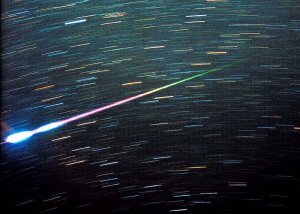| Sky At a Glance, November 20, 1998 - It seems that this past week's Leonid meteor shower peaked
a little ahead of schedule. Initially predicted to reach maximum at 19:43 Universal Time on November 17th -- when
the Earth crossed the orbit of parent comet 55P/Tempel-Tuttle -- the highest rates apparently came about 15 hours
earlier. European observers may have had the best of it as dazzling fireballs came every few seconds -- sometimes
several at the same time. Based on dozens of reports from observers throughout the United States, meteor watchers
under clear skies were not disappointed on the night of November 16-17, but rates were markedly lower the following
night. No damage to Earth-orbiting satellites has been reported.
How will the showing of Leonids this year affect astronomers predictions for 1999? As Donald K. Yeomans (Jet Propulsion
Laboratory) told Sky & Telescope: "My prediction for 1999 won't change but I suspect the
dust particle cloud modelers will revise their predictions somewhat. If nothing else, an early arrival of the Leonid
'peak' (if that indeed turns out to be the case) shows how difficult it is to predict a very complex process --
rather like trying to predict the weather a year in advance."
The next major meteor shower is the Geminids. See the December 1998 issue of Sky
& Telescope for details.

Leonid Meteor Burst, November 17, 1998, by Robert Reeves, San Antonio, TX
Links to 1998 Leonids Web Sites
LIVE WEBCASTS RE LEONID METEORS
OFFERED BY JAPANESE OBSERVATORIES (fwd)
Date: Fri, 13 Nov 1998 6:20:17 -0500
Subject: LIVE WEBCASTS RE LEONID METEORS OFFERED BY JAPANESE OBSERVATORIES
THE FOLLOWING ADVISORY WAS RECEIVED FROM THE PUBLIC RELATIONS CENTER OF THE NATIONAL ASTRONOMICAL OBSERVATORY OF
JAPAN, IN TOKYO, AND IS FORWARDED FOR YOUR INFORMATION. (FORWARDING DOES NOT IMPLY ENDORSEMENT BY THE AMERICAN
ASTRONOMICAL SOCIETY.) CONTACT DATA ARE AT THE END.
Steve Maran, American Astronomical Society
FOR IMMEDIATE RELEASE (No. 98-11, NAOJ)
Exciting Leonids meteor shower on November 17 will be shared with the world: Internet Live planned from Japan
The starry sky of the early morning on November 18 in Japan may be filled with bright meteors. In order to share
this excitement of the universe with people all over the world, several trials of an "internet live"
broadcasting are planned.
The coming storm of the Leonids is expected to peak around 20 h UT on November 17, which corresponds to 5 h local
time on November 18 in Japan. Japan is doubtless the most favorable place to witness the peak. A NASA airborne
mission, which consists of two research aircraft, will visit the Japanese sky in order to perform comprehensive
scientific observations of the Leonids.
In this situation, people living in the area outside Eastern Asia and Western Pacific may miss the Leonids peak
directly. However, they do not need to give up. We, the Japanese astronomical community with a help of an internet
company, are planning to broadcast it for those people. At the press conference of the Leonids held at the National
Astronomical Observatory of Japan on November 10, we introduced the following activities related to the "Internet
Live" of the Leonids in Japan.
1:Live from Saji Observatory, Tottori prefecture.
2:Live from "Live! Leonids 98", including Mt. Fuji, Hakkai-san, and Misato Observatory, Wakayama Prefecture.
3:Live from Mt.Yatsugatake, Yamanasi-pref. Japan
4:Milkyway Live from Agawa village, Kochi Prefecture.
All these efforts are performed by so-called public astronomical observatories, which have been built by local
governments as a part of scientific education for the general public. There are more than 200 observatories, and
most of them have relatively large telescopes. Main purpose of these observatories is public service in educational
aspects of astronomy and related sciences. We believe that these observatories are playing an important role in
education on astronomy. Our Public Relation Center is supporting these observatories by supplying many kinds of
information on astronomy, and participates in cooperative programs like these events.
FOR MORE INFORMATION, CONTACT:
Directly to each web site administrator, or
Dr.Jun-ichi Watanabe watanabe@pub.mtk.nao.ac.jp
Public Information Office, Public Relation Center,
National Astronomical Observatory,
Osawa, Mitaka, Tokyo 181, Japan
Phone:+81-422-34-3638
FAX:+81-422-34-3810
|